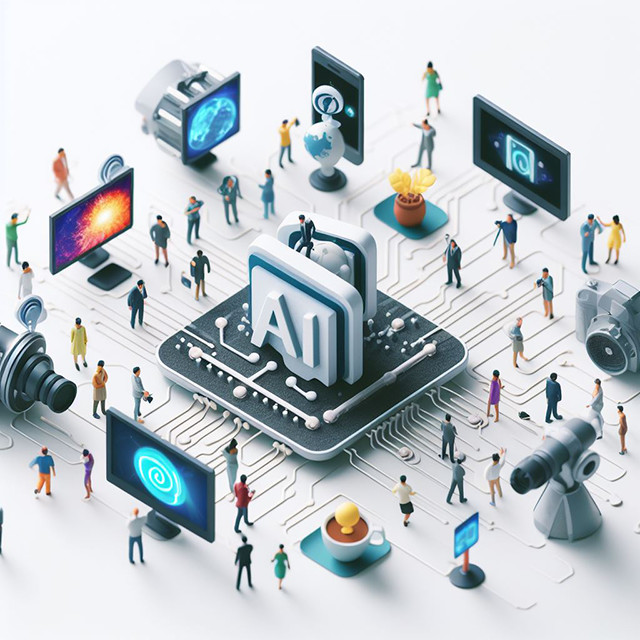Examining Copyright Challenges in Training AI Models on Massive Datasets
Recent breakthroughs in artificial intelligence (AI) have been driven by substantial increases in model scale enabled by computational advances. However, the vast data requirements of large neural network models raise critical questions around copyright compliance and attribution norms. In this paper, we analyze the copyright risks emerging from current AI training paradigms and present recommendations for responsible practice.
AI Models Require Massive Training Data
Most leading AI systems employ a transfer learning technique for model development. Models such as DALL-E 2, GPT-3, and Stable Diffusion are first pre-trained on large corpora of text, images, audio, video and other data scraped from publicly available sources. For instance, GPT-3 was trained on hundreds of billions of text tokens from books, Wikipedia articles, and webpages.
Unsupervised pre-training objectives teach the models to encode generalized data representations across modalities and domains. Subsequently, the models are fine-tuned on downstream tasks using modest amounts of supervised data. This transfer learning approach allows models to acquire versatile capabilities from broad unlabeled corpora that transfer reasonably well to specialized tasks. However, web-scale scraping of pre-training data has concerning copyright implications we detail below.
AI Outputs Risk Copyright Infringement
While today's AI systems do not comprehend semantic content, they exhibit abilities that could leverage copyrighted data in legally questionable ways:
- Direct reproduction of protected works when prompted.
- Mimicking the style of creators given samples of their work.
- Generating derivative adaptations of copyrighted materials.
- Extracting and translating copyrighted information into new formats.
These abilities potentially infringe intellectual property rights if undertaken without authorization from rights holders. Additional legal analysis is required as norms evolve.
Documented Copyright Controversies
Several documented cases have illustrated the copyright challenges with existing AI systems:
- Non-consensual training data scraping resulting in art theft allegations against DALL-E Mini.
- Getty Images lawsuit against Stability AI for alleged copyright infringement through unauthorized training data use.
- Admitted use of copyrighted anime art by NovelAI later removed after community backlash.
These cases underscore the need for greater caution and compliance in AI development cycles. Next we present emerging solutions.
Technical Solutions for Copyright-Compliant AI
Various approaches have been proposed to reduce copyright risks in AI systems:
- Curating training data through manual screening.
- Developing attribution techniques to link outputs to training origins where viable.
- Licensing copyrighted data for permissible reuse.
- Engineering models to respect intellectual property rights via content filtering and response shaping.
- Watermarking generative outputs to enable monitoring for misuse.
- Performing ongoing legal reviews and compliance audits during model development.
Adopting such solutions alongside cautious data sourcing and documentation practices can help mitigate copyright issues in AI systems.
Principles for Responsible AI Creation
Based on learnings to date, we propose the following guiding principles for developing AI responsibly:
- Acquire proper licensing for any copyrighted data used in training datasets rather than simply scraping content.
- Perform rigorous auditing of training corpora to document provenance and exclude unlicensed intellectual property.
- Enable access to clear attribution and citation information linking AI outputs to their training data origins.
- Implement stringent oversight of model training and deployment by IP law experts at every stage.
- Engineer models to behave ethically by refusing prompts that violate copyright or other harms.
- Develop viable ways to share value with human creators who contributed important training data.
Adhering to principles of lawful sourcing, attribution, compliance, oversight and creator compensation can help foster AI that enhances creativity while respecting rights.
The Role of Laws and Policy
Ultimately, adapting IP laws and policies will also be necessary to provide normative clarity on acceptable versus infringing AI training data uses at scale:
- Updating copyright laws to account for the novel recreation risks posed by neural network generative models.
- Establishing clear fair use guidelines tailored to training AI systems rather than just individual human creators.
- Funding research into rights-preserving machine learning techniques and data documentation.
- Constructing centralized registries and unique digital identifiers to improve attribution.
Lawmakers, courts and legislators will play a key role along with AI developers in codifying ethical training norms.
Outlook on Responsible AI Innovation
As AI capabilities grow exponentially, ensuring models respect copyright, attribution and licensing norms will only increase in importance. With proactive coordination across the AI community, policymakers and content creators, these technologies can develop into tools that expand human creativity while protecting authorship rights. By recognizing these challenges early and taking concrete mitigating steps, we can preemptively steer AI progress in an ethical direction, upholding creative freedoms.
Perspectives from Barcelona on Ethical AI Development
In this official catalan report about AI, especifically around page 119, the authors emphasize the risks related to illegitimate data collection, lack of transparency, discrimination, and improper data reuse.
The report highlights that intensive personal data use by automated decision-making algorithms (ADAs) often conflicts with General Data Protection Regulations (GDPR) principles of purpose limitation and data minimization. While AI advances may benefit from data abundance, accuracy and legitimacy must also be ensured.
The authors recommend responsible design practices including transparent documentation, bias testing, and compliance reviews. They conclude that in Barcelona and beyond, coupling ethical technology with sound governance is essential to realize AI's benefits while respecting rights.



Comments
Post a Comment